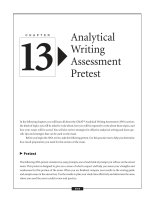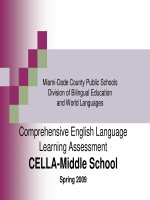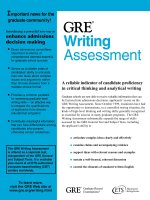initial assessment info
Bạn đang xem bản rút gọn của tài liệu. Xem và tải ngay bản đầy đủ của tài liệu tại đây (79.9 KB, 1 trang )
English Banana.com
Schools
Initial Assessment – Information Page
The initial assessment is a four-page document with an accompanying marking guide and key
which is divided into a reading and writing assessment and a speaking and listening
assessment/interview. It should be given to students before they start the course. It helps the
school or teacher to determine which level the student should be in – Beginner, Elementary or
Intermediate. You should print all four pages and staple them together for each student. All
students should attempt all of the questions. The questions are easy to start with but get
progressively more difficult with each page.
The idea behind the reading and writing initial assessment is that if students can complete
some of page 1 but none of the next two pages they are at Beginner Level for reading and
writing. If a student completes page 1 easily but is having problems with some of the work on
page 2 (e.g. the past simple verbs), they are at Elementary Level. If a student sails through
pages 1 and 2 and is able to do some of page 3, but has problems with the rest of the page
(e.g. question 4’s gap-fill) they are at Intermediate Level. Each page is based on topics that
students will cover at each of the three levels: page 1 = Beginner Level; page 2 = Elementary
Level and page 3 = Intermediate Level. If a student gets full marks or almost full marks on all
three pages they are probably at a higher level than Intermediate, which the materials in this
pack do not cover. Such a student should be referred to a higher-level course.
The final page is the speaking and listening assessment, which takes the form of an informal
interview carried out by the teacher on a one-to-one basis with each student. Like the reading
and writing assessment, the questions are easy to start with but get progressively more
difficult. You should tick to show the student’s response to the questions that you ask, ranging
from “no response” through to “proficient”.
If a student is doing well and answering with mainly Ds and Es to start with, keep going to the
Elementary Level questions. If they are stuck on the easy questions, they are at Beginner
Level. If they are stuck on the hardest questions, they are at Elementary Level. If they are
able to get at least Cs or Ds for the hardest questions then they are at Intermediate Level.
Again, if a student can answer all of the questions fluently with only a few minor mistakes,
they are at a higher level than Intermediate Level, which our schemes of work do not cover.
You can always devise your own course for Advanced Level students.
It is not necessary to ask all of the questions with every student and you can cut any of the
questions, or add your own, as required. You will soon start to get an idea of a student’s
speaking and listening level as you spend time talking with them. This list of questions is
designed to be give prompts for the teacher as to what to ask each student and also to
provide a permanent record of the level of the student’s speaking and listening skills at the
time of the assessment. All of the initial assessment pages can be adapted, with questions
deleted or added as required. In providing all of the materials in this pack as Word .doc files
we have aimed to make them as adaptable and flexible as possible.
Spiky Profiles:
Some students may have a “spiky profile”, which means that they are at one level for one skill
and at a different level for another. For example, they are much better at speaking and
listening than they are at writing, or they are much better at reading and writing than they are
at speaking and listening. This could happen in any combination. It’s up to you whether you
plan a mixed level course based on both the schemes of work in this pack, or whether, for
example, you want to put a student who is at Elementary Level for reading and writing but
Beginner Level for speaking and listening in an Elementary Level class and provide extra
speaking and listening practice for them. You could show this differentiation on the student’s
ILP (Individual Learning Plan) as well as on the lesson plan.
English Banana Schools









